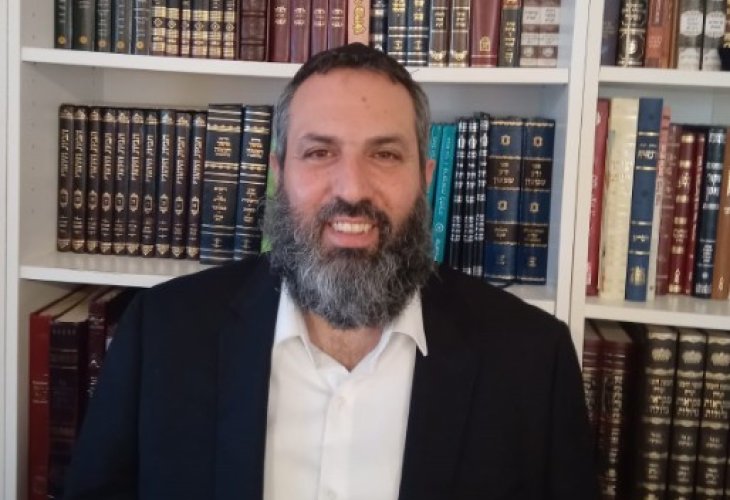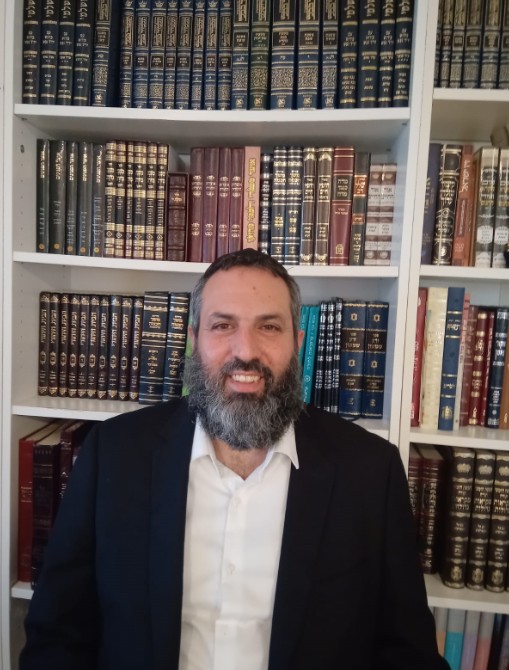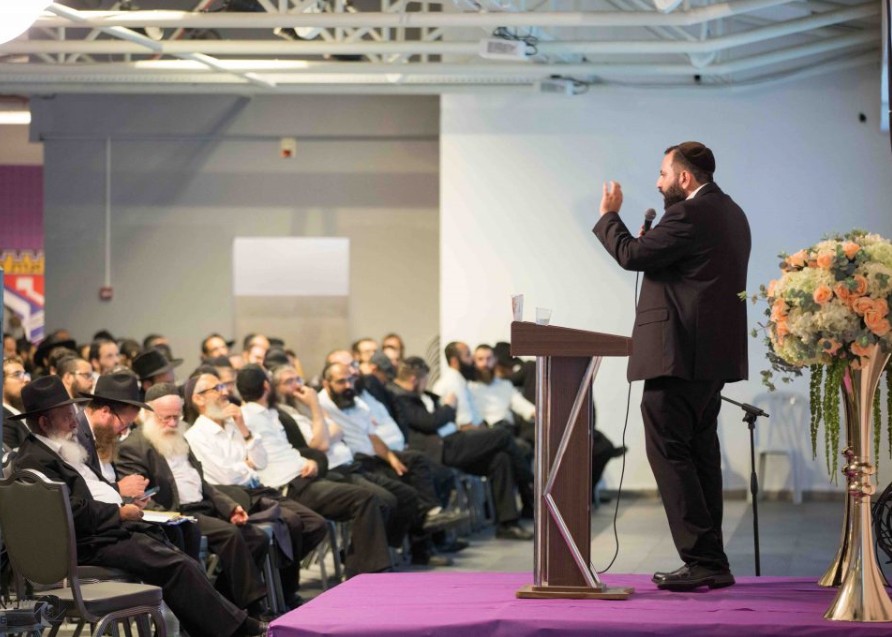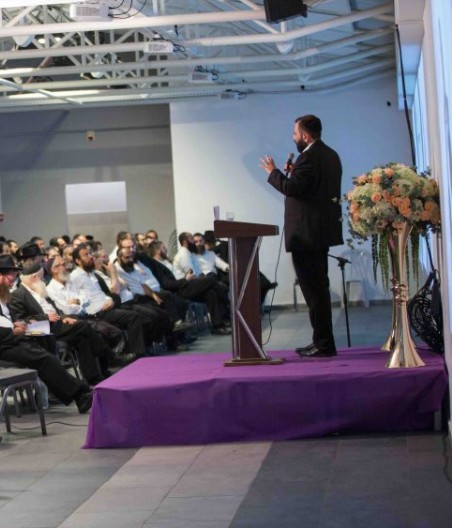Master of Creative Thinking: "Thinking Outside the Box is the Secret"
Rabbi Raphael Cohen, an expert in creative thinking, advises and lectures on this topic to companies and organizations in Israel and abroad, revealing secrets and explaining how changing one's mindset can solve life's problems and bring real change.

"Thinking outside the box" are the words repeatedly emphasized during the conversation with Rabbi Raphael Cohen. He quotes these words when explaining what led him to return to faith about 18 years ago, underscores them when discussing his current work, and offers them as a valuable tip to anyone constantly searching for answers and wanting to solve life’s emerging problems.
Seeing All Layers
"Thinking outside the box is a type of thinking I've identified with since I was a young child," says Rabbi Cohen, "and indeed, it accompanies me to this day, as I give lectures and guide organizations and individuals on how to avoid sticking to automatic thinking and instead, try to think a bit more creatively."
According to him, such thinking usually does not come naturally. "As humans, we tend to prefer not to trouble ourselves too much, thinking automatically. Sometimes there is an advantage to it because automatic thinking saves us energy and effort. We might sit behind the wheel, start the car, and arrive at our destination without being able to explain how we got there. This is an automatic process created in our brain."
"The problem with automatic thinking is that it causes us to miss and not see additional paths and new ways," claims Rabbi Cohen, and this is where he steps in, attempting to develop the field not taught anywhere in the world, not even in universities - creative thinking. "Not just thinking, but also initiating," he emphasizes, "seeing the new and refreshing directions not visible from a superficial glance. It is the key to success and progress."

This way of thinking he began conveying even before returning to faith. He lectured before major companies, such as banks and high-tech firms. He even traveled abroad with his lectures. Since returning to faith, Rabbi Cohen has combined creative thinking with a Jewish and spiritual perspective. "I see it as a special mission," he says, "because usually when I'm invited to lecture, they don't expect me to add my Torah knowledge, but when I see the audience is attentive and eager to listen, I try to talk about Judaism and, blessed be Hashem, I have the merit to greatly increase the public’s merit."
According to him, the most popular question he encounters is: "How can a religious person talk about innovation and thinking outside the box? Isn't Judaism itself uncreative, filled with dry laws and rules?"
What do you reply to that?
"It's an opportunity for me to explain to the public what Judaism is. I talk about how Judaism has many directions and layers, as there are seventy facets to the Torah. In the Talmud, we can see the debate between Bet Hillel and Bet Shamai. The beauty is to approach Judaism from all its angles – from above, below, and also from the sides."
"One example I love to give in this context relates to the well-known acronym 'PaRDeS' - Pshat (simple understanding), Remez (hints), Drash (exegesis), and Sod (secret). I explain what we, as Torah learners, know – that within every biblical text there is, besides the text itself, 'Remez' – things hinted at through numerology, acronyms, etc., that shed light on what is said. Additionally, there is 'Drash' – interpretations told by our sages about what happened behind the scenes, and also 'Sod' – encompassing matters related to Kabbalah, Chassidut, and the inner dimension of the Torah. After I explain this, I mention that the PaRDeS exists in every area concerning creative thinking in any subject. I suggest they imagine someone entering a room and standing before the audience. Initially, we try to ‘judge’ and ‘categorize’ them, but we really don’t know who they are, as we only see one layer. That's what 'Pshat' is, and if we pay attention, with letter change, it becomes 'Shaphat', meaning we mustn’t be judgmental because not always what we see externally is the true reality."
"In the next stage, we move to 'Remez' – 'Who are you, sir? Where do you live, and where do you work?' Thus, we gain another perspective on the person before us. Then we move to 'Drash', essentially inquiring and investigating: 'What are your hobbies, sir? What do you love doing?' Only finally do we reach the last layer, which is 'Sod' – 'Who are you really? What do your soul and inner self look like? What is your mission?' This is the most genuine layer we can see in a person standing before us, comprised of so many layers. Creative thinking involves observing all the layers that can be seen, understanding they’re always present even when invisible."

Creative Thinking
In what situations in our lives will we need creative thinking?
"We can see it, of course, in the work domain. When a problem arises at work, we can analyze it and see how it encompasses additional angles and layers, and accordingly, solve it. By the way, when seeking a solution, it's important to note that sometimes the problem itself can be our best and most creative solution."
What do you mean?
"We can see examples in many areas. For instance, in Brazil, there was once a juice manufacturing company that faced a severe crisis because pieces of fruit from which the juice was made got stuck in the machines. This resulted in high costs and led to significant problems, almost leading to the factory's closure. One day, an employee came up with a brilliant idea: 'Let's take the problem itself, the pieces of fruit stuck in the machines, and use it as a solution - we'll offer people special juices with fruit pieces inside.' From that moment, sales increased and soared, proving that sometimes the problem itself can be a solution.
"This idea also came up with a good friend of mine. He owned a large Jewish book store and sold many books through it. One day he was invited to a big exhibition near Paris, offered to rent a booth and sell books there. He invested a lot in this and even took the trouble to print beautiful catalogs in French, which he hoped to distribute at the exhibition. The day of the flight arrived, and he and his wife boarded the plane with the catalogs in their hands. During the flight, his wife, who understands French, was looking through the catalog and started to feel bad. She told her husband: 'There are so many mistakes here; if the French read this, they'll laugh at us without end. We have no choice but to throw everything away'. My friend told me he was at a loss since these catalogs were printed at a very high cost, and he didn’t want to give them up. Fortunately, the idea came from his wife. She suggested: 'Instead of throwing away the catalogs, let’s hold a contest among the participants – whoever spots the most mistakes in the prospectus will enter a draw for free books.' And so it was; this idea led to great enthusiasm among the French crowd. People attending the exhibition couldn't stop being excited: 'The Israelis are genius.' Thus, a whole ceremony was held, at the end of which the mayor came, picked a note, and announced the lucky winner who found all the errors in the catalog... Amazing to think that when using a problem as a solution, you can succeed in solving things in the best possible way."

What would you suggest to people who claim they are not creative? People with a 'straight' mind who find it hard to think outside the box?
"My answer is straightforward – if you want to teach yourself to think differently, you must believe it's possible and that you're capable. Once you believe, you can try to acquire tools, techniques, and methods to think more creatively. The next stage is, of course, to implement and practice, because this kind of thinking does not come easily, and often we find ourselves being dragged by habit, but if we remember each time to stop ourselves at the right moment, we can break our habits positively, and find the most creative ways to advance in life."
Rabbi Cohen emphasizes that creativity can be beneficial not just in work, but in every field. "It's very prominent in the subject of relationships. Some couples seem to have everything in life, yet something doesn’t flow. The idea is to pause and instead of continuing to act in the same way as for years, try to think differently. Also in child education, so many times we apply the same methods repeatedly and don't understand why it's not working, whereas if we slightly alter our thoughts and take a different approach, suddenly we find the problems being resolved one by one."

Developments Outside the Box
Rabbi Cohen's creative thinking also led him to develop interesting and unconventional products, such as the 'Standing Haggadah'. This is a Passover Haggadah that doesn't lie flat on the table but stands on it. "About this, it is said 'and it stood'," he notes with a smile. "I thought of the idea a few years ago while sitting at the Seder table and seeing how cluttered it was, there was no place to put the Haggadot. Around the table sat mothers with babies, the wine spilled, and they didn’t even have a free hand to flip through. I tried to think outside the box and thus conceived the idea of the upright Haggadah. Afterwards, I received warm and special responses that proved to me just how useful and efficient the idea really is."
Rabbi Cohen also wrote several books, including 'The Torah Portion in Which You Were Born', considered a bestseller and sold in tens of thousands of copies. It was crowned for many months in the Steimatzky network as a bestseller in the non-fiction category. "The idea of the book," he shares, "is that it invites the reader on a journey of inner discovery through the Torah portion in which they were born. At the end of the book, there is a calendar where anyone can check exactly what portion they were born in, and when they review it, they discover truly fascinating things."

What fascinating things? Give an example
Rabbi Cohen asks for my birthdate, accordingly flips to Parashat 'Tetzaveh', which was read that week. "Parashat Tetzaveh is all about connection – teaming, bonding. It’s the ability to contain and listen. If you were born that week, you probably have excellent psychological abilities, interpersonal skills, and a high level of counseling ability."
Along with the compliments, Rabbi Cohen also speaks about additional insights specific to Parashat Tetzaveh concerning life itself. "People reading the book realize there is no randomness in life and everything is under divine providence. It isn’t a coincidence we were born in this or that portion. Sometimes there are even those who try to examine in which portion they married or in which portion they celebrated their Bar Mitzvah, and they see direct and amazing connections from the portion to their life, all in a creative and very fascinating way."
To purchase Rabbi Raphael Cohen's books at Hidabroot Shops, click here.

